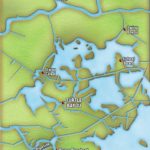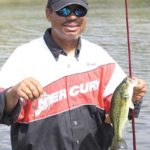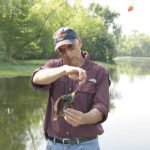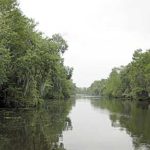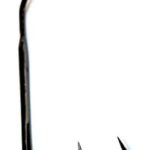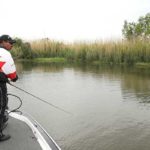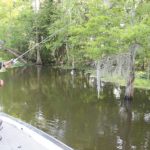
You should definitely be in a hurry to get to this south-central Louisiana hotspot.
It’s hard to know what all the hurry is about, but you would think running to a place called Turtle Bayou, by name alone, there wouldn’t be any rush.
Nonetheless, when it comes to fishing in this region, near Amelia, bass anglers are anything but slow when trying to get there.
At 60 mph, the skin on my face felt like it was coming off. The wind whipped up under my glasses so badly, my eyes welled up in tears. Needless to say, it was difficult to appreciate the terrain on the way to our destination, but one manages.
So getting back to that hurrying thing, if you’re not fishing a tournament, why break all speed records to get there this summer?
For one thing, in July, regardless if you’re fishing a tournament or have a need to just get out on the water and catch a few fillets, you want to be there before the other guys. For another, it’s hot at this time of year — really hot — and that means the best time to be on the water in this south-central Louisiana location is both early and late in the day. Whenever there’s a short window to fish, you want to get there as fast as you can.
Patterson local Gerald Foulcard fishes his share of local tournaments in and around Morgan City throughout the year. Invariably, he’ll make a number of trips to Turtle Bayou and its surrounding waters to both scout out potential hotspots and actually compete on tournament day.
“What’s so nice about fishing the Turtle Bayou area is you have the potential of catching a large fish at anytime,” Foulcard said recently while expounding on how a 5-pound, 8-ounce fish from the area won big bass for him during a tournament. “I usually catch my biggest fish there.”
It takes time and good habitat with plenty of food sources for bass to get big enough to put winning weight on the scales. And like most top bass locales throughout Louisiana, Turtle Bayou has its share of crawfish, baitfish, insects, frogs and so forth. In other words, there is no shortage of food sources.
It has a variety of different habitat that can’t all be covered even with the heaviest pressure from tournament anglers. Bass have plenty of places to hide, and fishermen can’t chuck every square inch of cover with their spinner-baits and lures. Foulcard’s 5-8 fish won’t be the last big bass tournament anglers will put in the livewell from the area.
“I like the terrain and geography,” Foulcard said. “There’s grassy stuff that’s like what you’d find in the marsh. There are long canals to fish, and there’s swamp-like terrain too. It just has so much variety.”
For anglers who simply prefer quiet days on the water — more like the turtle and not the rabbit — the terrain and fauna provide a serene appeal, perfect for reflecting and laying to rest the previous week’s issues.
Several canal banks are lined with cypress, tupelo and tall cottonwood maples that glisten with greenish-yellow hues of morning light. The prothonotary warbler hides in these soft colorful shades, and provides tranquil music to the rhythm of water lightly splashing against the sides of your boat. It really doesn’t get any better than this.
The Turtle Bayou region is also somewhat tidal, and water quality is influenced by the Atchafalaya River as it flows through Bayou Chene to Bayou Penchant and on into Turtle Bayou. Wind also can be a factor as well. Yet these influences are nothing to be concerned with, as the many canals throughout form a labyrinth of hydrology, where one bayou or canal can be stained and another beautiful.
It’s the amount of lush thick sub-aquatic grass that catches your attention when finding clear water. Not only is this grass teeming with baitfish, it also harbors some bonus bream and sac-a-lait action that is always a plus for the non-tournament bass angler.
That grass may present challenges for some, but Foulcard likes fishing the subaquatics.
“Bass like those grassy areas, especially during the summer,” he said. “It’s cooler beneath those mats of grass. What I like to do is fish with topwater baits — like a frog — where they’ll come up out of the grass and hit it. But I’ll also fish a spinnerbait really shallow along the edge of the grass. That’s been productive for me in the past. I’ll also use Senko soft plastics too.”
Quite often, partnering with Foulcard to fish a tournament is his younger brother Gary from Franklin. The younger Foulcard also topwater fishes using baits like the Stanley Ribbit in the early part of the morning. But post sunrise, he’ll change tactics by going deep.
“After the sun comes up, you might want to go down to the bottom and throw a Brush Hog or Zoom Speed Craw,” Gary Foulcard said. “Depending on the structure in the particular area of Turtle Bayou you’re fishing, you might also want to downsize the jig you’re throwing.
“If you’re using a spinnerbait, it can be either with tandem or Colorado blades. But in downsizing, you want to use something 3/8-ounce or less and not toss big, bulky baits. You want the smaller baits to mimic a baitfish.”
Turtle Bayou and the numerous canals have plenty of intersections and pipeline crossings that are also productive locations. These intersections have series of points where fish can hold outside of the stronger current and ambush their prey with criminal-like impunity. Additionally, due to tidal influence, a distinct clear and stained water line is present. Bass hang on the edges to feed on unsuspecting baitfish.
There are also differences in bass behavioral patterns where the tide is concerned, Gary Foulcard said.
“When you start talking about tides, fish perform better when the tide is going out,” he said. “You can use your spinnerbaits and Brush Hogs catching them better. But as the tide stops and is not moving, then you have to pitch a jig or something and go look for them.”
Flipping jigs along the many tupelo and cypress trees and any other semi-submerged structure is productive when the tide isn’t cooperative. The Stump Canal is a hotspot where anglers should start looking.
“You have to entice the fish to eat because they’re not going to feed as much,” Gary Foulcard explained. “They’re looking for it right in front of their faces.”
So beyond the weigh in and the early and late bite in July, why should you be in a hurry getting to Turtle Bayou? Did I fail to mention that the only air conditioning you’re going to get at this time of year in Louisiana is running wide open on top of the water at 60 mph?
